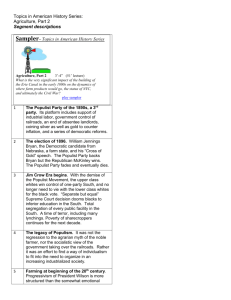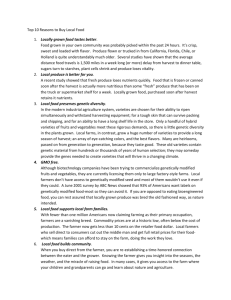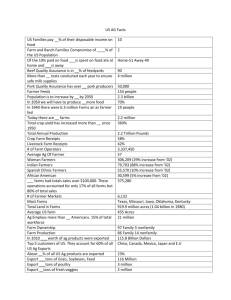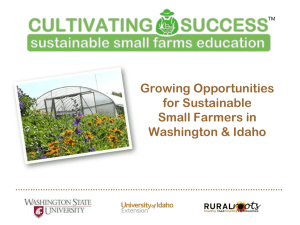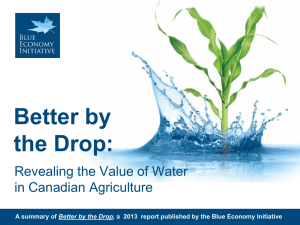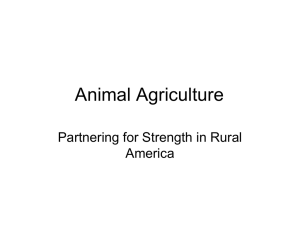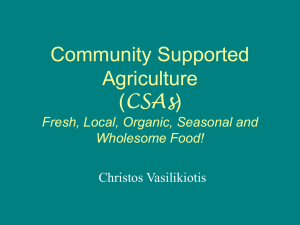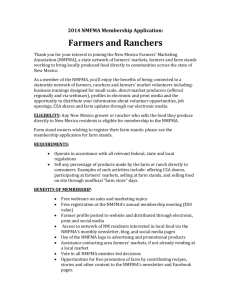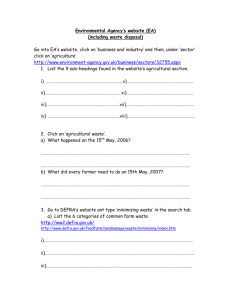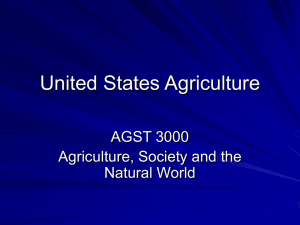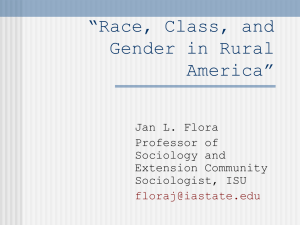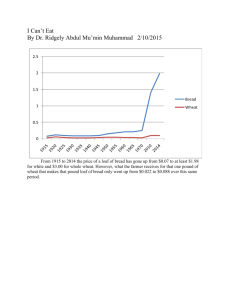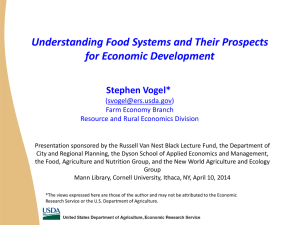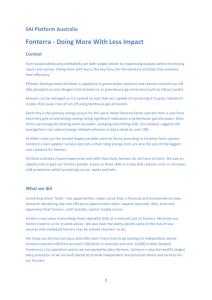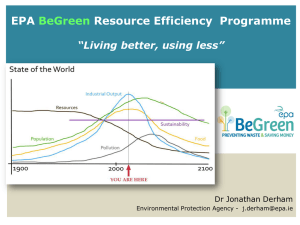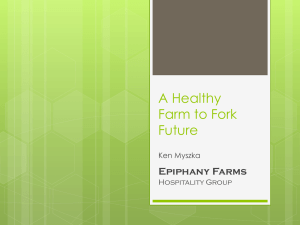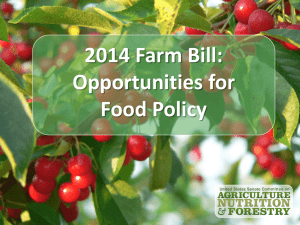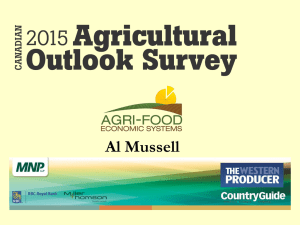Chapter 1 - Introduction - Agricultural Economics at McGill University
advertisement
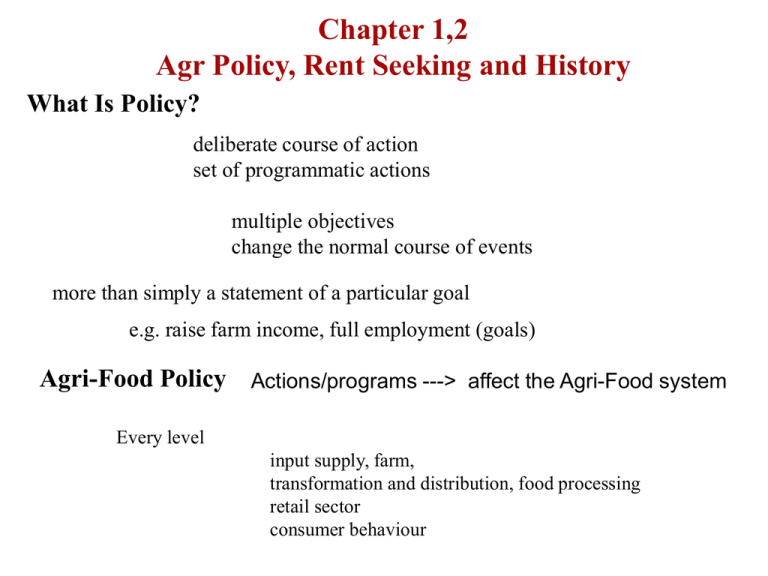
Chapter 1,2 Agr Policy, Rent Seeking and History What Is Policy? deliberate course of action set of programmatic actions multiple objectives change the normal course of events more than simply a statement of a particular goal e.g. raise farm income, full employment (goals) Agri-Food Policy Actions/programs ---> affect the Agri-Food system Every level input supply, farm, transformation and distribution, food processing retail sector consumer behaviour Who/What is involved with Policy? Who ? Everyone is involved - directly or indirectly > (democratic) Primary stakeholders -- > politicians + bureaucrats What Shapes Policy ? Preferences, Background, Attitudes, and Knowledge (P-BAK) (Brinkman) Knowledge Background Preferences Attitudes POLICY Values Facts Beliefs Goals Beliefs That Underpin Recent Federal Agr & Food Policy General: Support by Canadians for farmers and farm programs Farming - depends on trade for growth Globalization/trade agreements - fact of life Important for Canada to fully participate in trade negotiations Growing pre-occupation with environment and food safety issues Farmers: more competitive (bigger, technology, value added, risk management) more responsive to market signals – what the market wants more “self-reliant” – “free to manage their own operations” more diversity Government programs, relations, services: Inter-provincial trade barriers Support the role of market signals – vs direct supports Stable, predictable business environment Large regional differences; relative strengths/efficiencies Programs seen as equitable Smart regulation; C/B, environmental impact assessment, voluntary standards Food safety: important to Canadians, also for trade (traceability) Science based (evidence) regulation; defensible How We See/Interpret the World <= Background/Knowledge Matters Facts Matter, but so does experience Determinant of policy prescriptions This is a new experience - background Major Groups Involved in the Agr & Food Policy Process Consumers Input Supply Farm Sector Transport + Handlers Government NGO’s / INGO’s Processors, Retailers Trade Partners Other sectors The Challenge for Policy Makers Different people - different values and beliefs Conflicts - good and bad policy Choices - cannot please everyone Resolve beliefs about the issue Choose goals according to competing values Maximize welfare (economic welfare) choice involves everyone Government intervention has to be justified Times of Change in Agri-Food Policy Policy is made in a dynamic environment many choices to be made (provincial, federal, international) 2003 - BSE – how to respond 2012/13 Agricultural Policy Framework (Growing Forward) WTO – Doha round of agr. trade negotiations 2012 US Farm Bill Periodic trade disputes Is this different than in the past? Long history - constantly in a state of change always new challenges; demands/expectations farm sector, or consumers Political ground is always shifting liberals vs conservatives; different policy agendas What Motivates Policy Formulation? Two schools of thought: 1) market failure (market structure, environment) 2) rent seeking behaviour (Schmitz, Furtan & Baylis) Rent Seekers: farmers and agri-business, (PDR sector) "agri-food policy is about the extent to which governments affect the sytem and is affected by stakeholders in the system" Some Challenges to Policy Formulation 1) Who is a farmer and who is not? Historical targeting of farmers - welfare Who receives support from who does not Influences how policy will be designed Family Farms: used to dominate Now: - (hobby farmers; corporate farms) Ownership separating from labour Defining a Farmer: difficult land base sales off farm income operator or owner? Size of farms Should farm size determine who policy is designed for? (small – large) Post WWII - fewer, larger farms - farm consolidation - capital substitutes for labour - bigger machinery – capital intensity - Economies of scale - risk US – 85% of hog farms (1970) are gone Bigger farms have not solved "the farm problem" Post WWII productivity (2%) – real price decreases for farm commodities NFI – from market sources is unstable and declining Figure 1.3 Real Net Income 1950-1998 Real Net Income 1950 - 1998 (includes program payments) Risks in Farming (price - output) Price Risk - unstable prices for primary commodities - international market - demand/supply elasticities (price flexibilities) - storable commodities - perishable commodities - bargaining power Supply coordination (domestic and international) Motivation for marketing boards Canadian Wheat Board International Wheat Agreement 2008 food crisis – international stocks Output Risk - problem for individual farmers – output determined by weather - open markets: large international disturbance => world wide price impacts - hard to insure (public vs private system) - motivation for government crop insurance Farmer can influence outcome moral hazard + adverse selection Boom and Bust Cycles: Good times - Bad times - design of policy difficult Boom - mid-1970's (Great Grain Robbery) prices good - acquire more land, bid up land prices land important collateral asset land prices increase + capacity to borrow renew equipment - larger machines - more land Bust - 1980 - 1986 prices decreased (grain wars EU/US) interest rates high service long-term debt credit crunch - bankruptcy - farm crisis Market Structure: farmers – lack of countervailing power large numbers of farmers homogeneous product perishable commodities declining delivery points (grain and livestock) Cargill/ADM - 70% of Canadian beef slaughter contract farming quality and supply reliability farmer owns fixed assets limited alternative marketing outlets The Farm Problem Boom & Bust Cycles – low returns to labour & capital Why is there a persistent farm problem? Why has it not been fixed ? How should policy makers address the problem? Willard Cochrane: treadmill theory - technology Glenn Johnson: asset fixity, adjustment Don Paarlberg - government programs are the problem Susan Offutt - what is the problem anyway ? Define/Identify the Problem Simple solutions to complex problems can back fire Growing Conflicts Between Farmers & other Stakeholders 204 acres sold fall 2009 – Beckett farms near Markham Ontario Toronto Greenbelt – “robbed” farmers New Land Use Conflicts Forests being clear-cut Lost Ecological Services How to encourage better environmental stewardship

